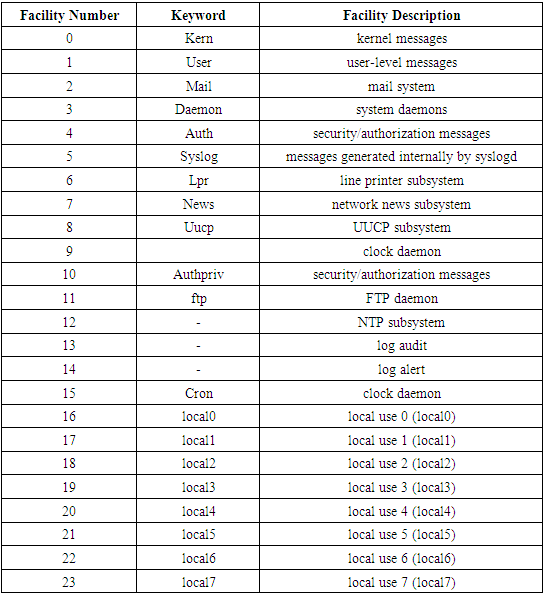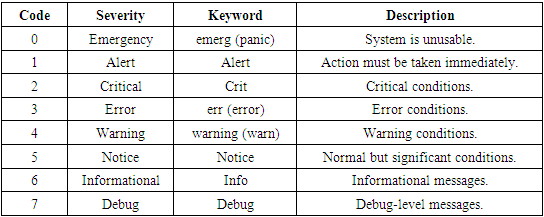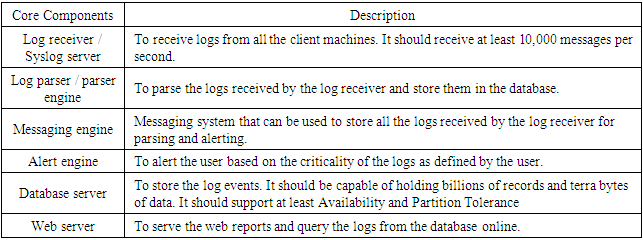-
Paper Information
- Paper Submission
-
Journal Information
- About This Journal
- Editorial Board
- Current Issue
- Archive
- Author Guidelines
- Contact Us
American Journal of Computer Architecture
2022; 9(1): 1-7
doi:10.5923/j.ajca.20220901.01
Received: Mar. 15, 2022; Accepted: Mar. 30, 2022; Published: Apr. 15, 2022

Implementation of High Available and Scalable Syslog Server with NoSQL Cassandra Database and Message Queue
Rajeshkumar Sasidharan
Systems Engineering, Scientific Games, Illinois, Chicago, USA
Correspondence to: Rajeshkumar Sasidharan, Systems Engineering, Scientific Games, Illinois, Chicago, USA.
| Email: |  |
Copyright © 2022 The Author(s). Published by Scientific & Academic Publishing.
This work is licensed under the Creative Commons Attribution International License (CC BY).
http://creativecommons.org/licenses/by/4.0/

Today’s IT infrastructure can be very demanding in terms of event logs storage and management. Thousands of devices, applications, operating systems, and appliances produce vast event log messages. Enterprise and service providers use third-party commercial log management software to collect data from the servers, storage, and network for alerting, auditing, and forensic purposes. This proprietary software is very costly and has limitations in terms of storage and clients’ licensing restrictions. This project aims to develop new log management software using the open-source tools Syslog and the Cassandra database. This project will reduce companies’ expenses and overcome the storage and client licensing limitations; using Syslog, it collects all the alerts, system events, and logs from the servers, network devices, and storage components, which are then stored in the database for future reference. Additionally, the team is alerted whenever a rule matches an event or an alert is received from the client machines. The proposed software will help the team proactively act on an incident before it becomes a problem. The Cassandra database can hold multiple terabytes of data and provide high availability by replicating the database on multiple servers. Finally, this project saves millions for the service provider by successfully managing banks, corporate accounts, and retail customers’ logs and events messages for auditing and forensic purposes.
Keywords: Open-source log management software, Syslog, AMQP, NoSQL, Syslog server, Distributed database Syslog server, Cassandra database Syslog application, NXLog, Apache, PHP
Cite this paper: Rajeshkumar Sasidharan, Implementation of High Available and Scalable Syslog Server with NoSQL Cassandra Database and Message Queue, American Journal of Computer Architecture, Vol. 9 No. 1, 2022, pp. 1-7. doi: 10.5923/j.ajca.20220901.01.
Article Outline
1. Introduction
- Our client is an Internet Service Provider (ISP), Enterprise Service Provider (ESP), and cloud service provider, so they manage thousands of server network devices for hundreds of enterprise and retail customers, including their infrastructure and environments. Therefore, maintaining uptime commitment and Service Level Agreement (SLA) is the primary criteria in terms of providing better service to their customers. Uptime and SLA primarily depend on the way in which events, incidents, and problem management are addressed. Event management helps quickly resolve incidents before they require problem management mode. Therefore, monitoring event management is a critical task that requires the right software to address the issue. Most of the problems can be addressed when the event is properly assessed by the operation team. Capturing events becomes more important as it initiates the next step of monitoring and alerts the relevant team.Since the relevant team is responsible for customer infrastructure and setup, they need to protect the system from external intruders. Any attempt made by intruders must be clearly captured through Syslog and addressed through necessary actions. Events captured through Syslog will be analyzed and ameliorated in the OS and applications services. Therefore, events captured through Syslog will help improve the performance of the system and alert the operation team of any malfunction of the OS and its applications or unwanted attempts by external intruders. In addition, it is useful for auditing and forensic purposes.
2. Syslog – An Overview
- Syslog is a standard for computer data logging. The Syslog protocol utilizes a layered architecture, which allows the use of any number of transport protocols for the transmission of Syslog messages [1].Syslog messages should be captured and stored centrally; this practice is now an unavoidable task for enterprise providers who support customers’ servers, appliances, and all network and storage components [1].Syslog captures all of the OS and its related messages, including warnings, errors, and critical events, which is required for compliance during an audit. It will be widely used for forensic purposes and to analyze and trap all the events during unavoidable incidents [1].Syslog Facility Level Values:
|
|
3. Problem Statement
- Presently, our client is using commercial log management software that is licensed based on the number of devices and storage space. However, our client manages thousands of devices, and that number is growing every day; hence, this license model does not work. The log management appliance is a non-customizable and locked product; also, it does not have high availability or scalability. In addition, it has a flat-file mechanism for storing logs, which degrades the performance of queries. It supports only limited events per second; therefore, the possibility of dropping event messages is very high. To increase the events per second acceptance, the client must buy the higher-end devices. Their current software has many graphical interface screens and report formats available, which is good, but our client is using only a limited number of the features.a. Syslog events are stored in a flat file, which is cumbersome to process, and it is difficult to query reports based on the day, week, or month.b. Storing the logs in the MySQL database is sufficient, and it does support millions of records. However, when the database reaches billions of records, it degrades the system’s performance. Writing data into the MySQL database creates a bottleneck when the number of transactions is so high.c. Therefore, considering the database used to store the logs for this project, events and alerts should be highly available, scalable, and high-performance.d. Regarding the Syslog software, we must consider high availability, scalability, performance, and zero log loss capability, as the existing commercial software is dropping events when it reaches its threshold.e. Our client has multiple data centers split across multiple geographic areas and thousands of devices. Therefore, designing the product should be foolproof and stable, and it should ensure the logs are transferred from one location to another location using a secure and reliable method.f. Copying the logs as files from one datacenter to a central datacenter server can be reliable, but it does not help in retrieving the run time report from the central database server.In summary, the Syslog server, database server, and log transfer application should not only be open-source but should also be high performance, scalable and reliable, and easily manageable.
4. Requirement Analysis & Decision
- We conducted several meetings and discussions with all of our client’s stakeholders, carefully captured all the requirements, prepared the final draft, shared it with everyone, and obtained approval to proceed to select the software from the open-source market.We finally decided to use log management software that meets the following minimum core components.
|
|
4.1. NXLog and Its Features
- NXLog can work in a heterogeneous environment to collect event logs from thousands of different sources in many formats. NXLog can accept event logs from Transmission Control Protocol (TCP), User Datagram Protocol (UDP), files, databases, and various other sources in different formats such as Syslog and windows event log, among others [3].We do consider the NXLog as our Syslog server because it has high security and high-performance I/O can receive messages from thousands of devices, can process 100,000 EPS (events per second), and supports Transport Layer Security (TLS) / Secure Sockets Layer (SSL), which ensures that the logs are transferred across the network in a secure mode [3].Therefore, NXLog has met the performance, security, reliability, and high-availability parameter requirements, and after conducting a basic level of testing and sharing the output with all the stakeholders, it was accepted as the Syslog server for this project.
4.2. Cassandra Database
- Apache Cassandra is an open-source, distributed, decentralized, elastically scalable, highly available, fault-tolerant, tunable, consistent, column-oriented database that bases its distribution design on Amazon’s Dynamo and its data model on Google’s Bigtable [2].We can replace failed nodes in the cluster with no downtime, and data can be replicated to multiple data centers to offer improved local performance and prevent downtime if one data center experiences a catastrophe such as a fire or a flood.Based on Brewer’s CAP theorem, which states that “within a large-scale distributed data system, there are three requirements that have a relationship of sliding dependency: Consistency, Availability and Partition Tolerance” [5]. Consistency: All the database clients will read the same value for the same query, even given concurrent updates [5]. Availability: All database clients will always be able to read and write data [5].Partition Tolerance: The database can be split into multiple machines; it can continue functioning in the face of network segmentation breaks [5]. Brewer’s theorem states that only two of the three can be strongly supported.Cassandra chooses Availability and Partition Tolerance from the CAP guarantees, compromising on data Consistency to some extent. Cassandra’s design and its label are “eventually consistent” [2].
4.3. Messaging System
4.3.1. Advanced Message Queuing Protocol
- Advanced Message Queuing Protocol (AMQP) is an open internet protocol standard for message-queuing communications and is also called the wired protocol [2].The defining features of AMQP are message orientation, queueing, routing (point-to-point and publish-and-subscribe), reliability, and security [2].
4.3.2. Apache QPID
- Apache QPID is a cross-platform enterprise messaging system that implements the AMQP, providing message brokers written in C++ and Java along with clients for C++, Java JMS, Net, Python, and Ruby. It also transfers messages from one system to another without any issue. It is a reliable and secure messaging system, and it supports high availability and ensures no data loss. Apache QPID implements the latest AMQP specification, and it is a 100% AMQP-enabled framework. It allows users to create multiple queues in the server and it also supports creating queues during runtime. It supports transaction management, queuing, distribution, security, management, clustering, federation, heterogeneous multi-platform support, and much more [6].
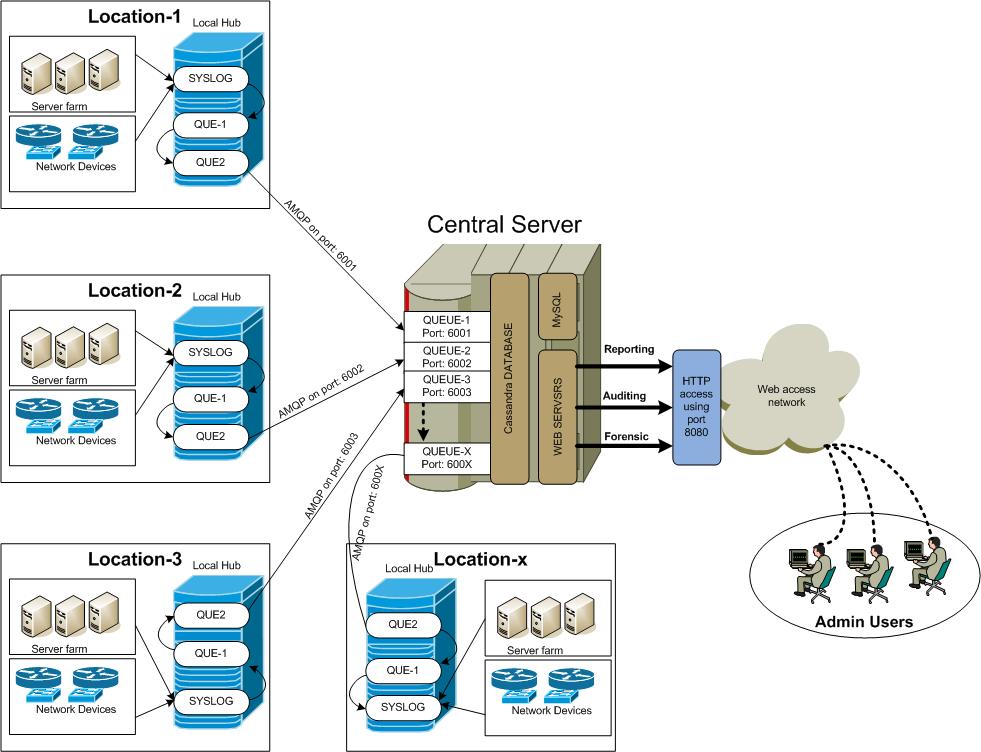 | Figure 1. High-level architecture |
4.4. Web Module Components
4.4.1. Apache Server
- Apache is one of the best open-source web servers on the internet, and it is a powerful, flexible HTTP/1.1 compliant web server that is actively being developed [8].
4.4.2. PHP
- PHP is an open-source general-purpose server-side scripting language originally designed to produce dynamic web pages. It has improved considerably, and many features are available since it has begun trying to compete with major server-side web application languages [7].
4.4.3. MYSQL
- MySQL is the world’s most popular open-source database, and it helps to deliver high-performance and scalable database applications. It supports multiple storage engines such as InnoDB and MyISAM. It also supports replication and partitioning [9]. We decided to use MySQL as a backend for storing customer information such as usernames and passwords, and we also use it to keep the filtering rules for logs to alert users.
5. Solution Design
5.1. High-Level Architecture
- The high-level architecture encompasses the complete flow of the application, the client’s data centers in multiple locations, and the thousands of devices that are installed in each data center.The events and logs will be accepted by the location hub server, and all the logs will be routed to the central server queue on a defined port using the Apache QPID application through AMQP. From the central server, all the logs will be stored in the Cassandra database, where the administrative users will connect through the web to access the logs and reports.
5.2. Central Server Architecture
- In the central server, Apache QPID, the Cassandra database, MySQL, and Apache will be installed.
 | Figure 2. Central server architecture |
5.3. Hub Server Architecture
- In the location hub server, NXLog, Apache QPID and an alerting engine have been installed.NXLog will be installed in the location hub server to accept logs events from the thousands of client machines and forward them to the Apache QPID AMQP server queue. The alerting engine is the proposed program, which was developed in C++. It connects the central server to the MySQL database and fetches all the rulesets and stores them in the in-memory cache for faster access. It then reads the message from the queue and checks the ruleset. If it matches, it triggers an email to the respective server logs administrator and moves the message from queue 1 to queue 2.
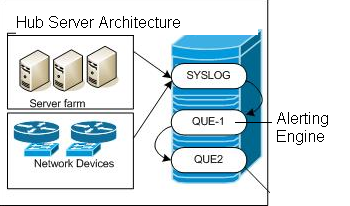 | Figure 3. Hub server architecture |
5.4. Parsing Engine
- The parsing engine is a program developed in C++ and implemented only on a central server, as it is not required in the location hub server. It reads the messages from the messaging queue and writes them to the Cassandra database server. Once they are written to the database, the message will be removed from the messaging queue. The alerting engine will not be implemented in the central server the location hub server is already responsible for alerting. The parsing engine will run as multiple processes based on the number of queues, and it will map each process against the dedicated queue to read and delete the message once it is updated in the Cassandra database.
5.5. Alerting Engine
- The alerting engine we developed connects the central server MySQL database, fetches all the rulesets, and store them in the in-memory cache for faster access. It then reads the messages from the queue and checks the ruleset. If it matches, it triggers an email to the respective server log administrator and moves the message from queue 1 to queue 2.The alerting engine connects to the central MySQL database server on a defined period such as once every 2 hours, fetches all the rulesets and stores them locally based on their location.The users have been notified that their rule will start work only after the next fetch cycle. The same information has been circulated through the web interface during the time when alert rulesets are created.Alerting the engine is a single process since each location hub server will have only a single queue to accept messages from the client servers and appliances.The parsing engine will not be implemented in the location hub server as parsing is not required.
5.6. High Availability & Failover
- Multiple Central servers will be placed in production to provide high availability. Thus, if a server goes down completely or an application becomes unavailable, the other servers in the cluster will take care of it. As discussed previously, the crontab script that runs on the servers monitors the application's availability and restarts it when it goes down. If the script is unable to restart the program automatically, it will notify the administrative team. The same is true for the location hub server. Additionally, the entire server and apps will be monitored through the Client existing NMS application and alert the respective team, if there is an issue.
6. Reports
- The following reports have been developed based on the business and user requests:a) IP address-wiseb) Type-wisec) Description-wised) Event-wisee) Device type-wisef) Based on the Syslog severity level keywordAs we are capturing all the information from the events and storing it in the Cassandra database, the reports can be customized and altered at a later point in time.
7. Results Summary
- a. Cassandra database testing:During the testing phase, many Syslog files from the Unix machines were uploaded to the Cassandra database using scripts. The activity time was < 1 second, which is very satisfactory compared to other Relational Database Management Systems (RDBMS) databases. We have confirmed that the Cassandra database is effective in writing operations.b. NXLog performance testingWe tested NXLog by sending a large number of transactional logs to NXLog, and we confirmed that it supports 10,000 EPS. In theory, it supports 100,000 EPS, which is the number mentioned on their home page. c. AMQP Queue testingUsing Apache QPID, we configured and routed the messages from one queue to another in the remote server and ensured that the messages were reached successfully. We also tried to send more than 10,000 messages using the QPID AMQP queue and confirmed that it works at lightning speed.
8. Summary
- The new open-source log management software developed would save organizations money by reducing their present expenses. In addition, it can support more client machines in the future by adding extra disk space. It has been carefully designed to use only open-source software such as Apache, Cassandra, MySQL, Apache QPID and NXLog. The communities that support these products have a large developer base, and they have been on the internet for a long time. As all the components are open-source, we can change or customize the components and codes at any time based on our requirements.The proposed product has fulfilled all our requirements, such as high availability, scalability, performance, and reliability. Each and every component selected and implemented in this project fully supports the above-mentioned requirements. In addition, we have demonstrated that we developed a fully open-source product to replace the existing fully commercial log management software.
 Abstract
Abstract Reference
Reference Full-Text PDF
Full-Text PDF Full-text HTML
Full-text HTML